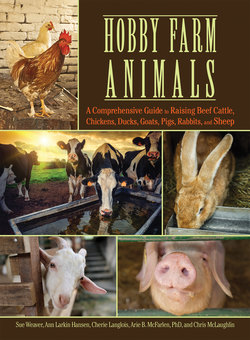Читать книгу Hobby Farm Animals - Chris McLaughlin - Страница 36
На сайте Литреса книга снята с продажи.
Getting Your Beef Processed
ОглавлениеDecades ago, every neighborhood where beef cattle were raised had a small-scale processing plant. Today, if you’re lucky, there will still be one in your area. If you’re not, you may have to drive a distance. Small-scale plants are completely different from the huge meat-packing plants with their assembly-line cattle processing. At a small plant, each animal is handled individually, and the plant owners and workers are often your neighbors.
Find a reputable plant by asking other beef producers their opinions. A reputation for making good sausage is a plus. You should then pay a visit. Don’t go in the morning, when most of the heavy work is being done and the staff may not have time to talk. Instead, head over in mid-afternoon, when it’s less hectic. The plant should look and smell clean. Talk to the manager, who is often also the owner. Most managers are willing to deal with beginners and will take the time to explain the entire process, from loading your steer onto a truck to picking up the meat. Ask how long it takes from the time the animal arrives at the plant to when the animal gets slaughtered; if it’s going to be a few hours, ask whether they make water available to the steer.
Ask about the processing charges. Most plants charge a per-pound processing fee, with extra charges for fancy butchering or sausage-making. If the plant picks up the steer from the farm, then there will also be a trucking charge.
Once you find a processor and make arrangements for your steer, you’ll be asked to decide how you want the meat butchered and packaged. Typically, you’ll need to tell them how thick to cut steaks, how many to put in a package, how big you want the roasts, and whether you want all of the round steaks and ribs or you want these ground for hamburger. You can specify that the heart, liver, and tongue be saved or discarded and that the tail be saved, if you’re fond of oxtail soup.
There will be a lot of meat. A typical 1,000-pound steer with good beef genetics will generally dress out to around 60 percent or better; dairy steers yield somewhat less. Sixty percent translates to 350-plus pounds of meat, an amount that will cram a large chest freezer right up to the top. If you don’t have room in your own freezer, most processing plants will rent you locker storage space for a very reasonable fee.
If there is no processing plant within a reasonable distance from your farm, you could check into on-farm butchering services. These operators will come to your farm, dispatch your steer, and do the initial skinning and dressing. You may have to do the packaging yourself, or you may be able to pay a little more and have them do it.
